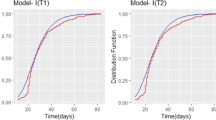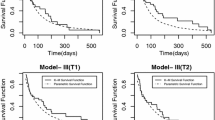Abstract
Traditional survival testing approaches have generally placed a premium on the frequency of failures over time. During the investigation of such cases, a lack of awareness of related observed and unobserved covariates may be detrimental. In this scenario, frailty models are a decent choice for examining the effect of unobserved covariates. We can easily find baseline distributions for such models. However, due to certain constraints such as the identifiability condition and the requirement that their Laplace transform exists, finding a frailty distribution can be difficult. As a result, in this paper, we introduce a new frailty weighted Lindley distribution for reversed hazard rate setup that outperforms the gamma frailty distribution. So, our main motive is to establish a new frailty distribution under reversed hazard rate setup. Generalized inverse Rayleigh and modified inverse Weibull baseline distributions are proposed as a useful tool for ensuring the effect of unobserved heterogeneity. The model parameters are estimated using the Bayesian framework of Markov Chain Monte Carlo methodology. Following that, Bayesian comparison methods are used to compare models. To explain the findings and show that better models are recommended, the famous Australian twin data set is used.





Similar content being viewed by others
References
Bakoban RA, Abubaker MI (2015) On the estimation of the generalized inverted Rayleigh distribution with real data applications. Matrix 2(2):2
Block HW, Savits TH, Singh H (1998) On the reversed hazard rate function. Probab Eng Inf Sci 12:69–90
Calabria R, Pulcini G (1996) Point estimation under asymmetric loss functions for left-truncated exponential samples. Commun Stat Theory Methods 25(3):585–600
Chacko M, Mohan R (2018) Bayesian analysis of Weibull distribution based on progressive type-II censored competing risks data with binomial removals. Comput Stat 34(4):233–252
Chen MH, Shao QM (1999) Monte Carlo estimation of Bayesian credible intervals and HPD intervals. J Comput Gr Stat 8(1):69–92
Clayton’s DG (1978) A model for association in bivariate life tables and its applications to epidemiological studies of familial tendency in chronic disease incidence. Biometrica 65:141–151
Cox DR (1972) Regression models and life tables (with discussion). J R Stat Soc Ser B 34:187–220
Duffy DL, Martin NG, Mathews JD (1990) Appendectomy in Australian Twins. Aust J Hum Genet 47(3):590–92
Flinn CJ, Heckman JJ (1982) New methods for analyzing individual event histories. Sociol Methodol 13:99–140
Ghitany ME, Alqallaf F, Al-Mutairi DK, Husain HA (2011) A two-parameter weighted Lindley distribution and its applications to survival data. Math Comput Simul 81(6):1190–1201
Hanagal DD (2019) Modeling survival data using frailty models, 2nd edn. Springer, Singapore
Hanagal DD, Bhambure SM (2017) Shared gamma frailty models based on reversed hazard rate for modeling Australian twin data. Commun Stat Theory Methods 46(12):5812–5826
Hanagal DD, Pandey A (2014) Gamma shared frailty model based on reversed hazard rate for bivariate survival data. Stat Probab Lett 88:190–196
Hanagal DD, Pandey A (2015) Gamma frailty models for bivariate survival data. J Stat Comput Simul 85(15):3172–3189
Hanagal DD, Pandey A (2017) Shared frailty models based on reversed hazard rate for modified inverse Weibull distribution as baseline distribution. Commun Stat Theory Methods 46(1):234–246
Hougaard P (1985) Discussion of the paper by D.G. Clayton and J. Cuzick. J R Stat Soc A 148:113–114
Hougaard P (1986) A class of multivariate failure time distributions. Biometrika 73:671–678
Hougaard P (1991) Modeling heterogeneity in survival data. J Appl Probab 28:695–701
Hougaard P (2000) Analysis of multivariate survival data. Springer, New York
Ibrahim JG, Ming-Hui C, Sinha D (2001) Bayesian survival analysis. Springer, Verlag
Kumar D, Singh A (2011) Recurrence relations for single and product moments of lower record values from modified-inverse Weibull distribution. Gen 3(1):26–31
Lindley DV (1958) Fiducial distributions and Bayes’ theorem. J R Stat Soc B 20:102–107
Mazucheli J, Coelho-Barros EA, Achcar JA (2016) An alternative reparametrization for the weighted Lindley distribution. Pesqui Oper 36(2):345–353
Oakes D (1989) Bivariate survival models induced by frailties. J Am Stat Assoc 84(406):487–493
Pandey A, Bhushan S, Pawimawha L, Tyagi S (2020) Analysis of bivariate survival data using shared inverse Gaussian frailty models: a Bayesian approach. In: Predictive analytics using statistics and big data: concepts and modeling. Bentham Books, vol. 14, pp. 75–88
Pandey A, Hanagal DD, Gupta P, Tyagi S (2020) Analysis of Australian twin data using generalized inverse Gaussian shared frailty models based on reversed hazard rate. Int J Stat Reliabil Eng 7(2):219–235
Pandey A, Hanagal DD, Tyagi S, Gupta P (2021) Generalized Lindley shared frailty based on reversed hazard rate. Int J Reliabil Qual Saf Eng. https://doi.org/10.1142/S0218539321500406
Pandey A, Hanagal DD, Tyagi S (2021) Generalized Lindley shared frailty models. Stat Appl 19(2):41–62
Sankaran PG, Gleeja VL (2011) On proportional reversed hazards frailty models. Metron 69(2):151–173
Santos CA, Achcar JA (2010) A Bayesian analysis for multivariate survival data in the presence of covariates. J Stat Theory Appl 9:233–253
Shaked M, Shantikumar JG (1994) Stochastic orders and their applications. Academic Press, New York
Tyagi S, Pandey A, Hanagal DD, Gupta P (2021) Bayesian inferences in generalized Lindley shared frailty model with left censored bivariate data. Adv Res Trends Stat Data Sci 1:137–157
Tyagi S, Pandey A, Agiwal V, Chesneau C (2021) Weighted Lindley multiplicative regression frailty models under random censored data. Comput Appl Math 40(8):1–24
Vaupel JW, Manton KG, Stallaed E (1979) The impact of heterogeneity in individual frailty on the dynamics of mortality. Demography 16:439–454
Acknowledgements
We owe a debt of gratitude to the anonymous referees who made numerous suggestions for improvement.
Author information
Authors and Affiliations
Ethics declarations
Conflict of interest
The authors declare no conflicts of interest.
Additional information
Publisher's Note
Springer Nature remains neutral with regard to jurisdictional claims in published maps and institutional affiliations.
Part of special issue guest edited by Dieter Rasch, Jürgen Pilz, and Subir Ghosh—Advances in Statistical and Simulation Methods.
Rights and permissions
About this article
Cite this article
Tyagi, S., Pandey, A. & Chesneau, C. Identifying the Effects of Observed and Unobserved Risk Factors Using Weighted Lindley Shared Regression Model. J Stat Theory Pract 16, 16 (2022). https://doi.org/10.1007/s42519-021-00241-9
Accepted:
Published:
DOI: https://doi.org/10.1007/s42519-021-00241-9




